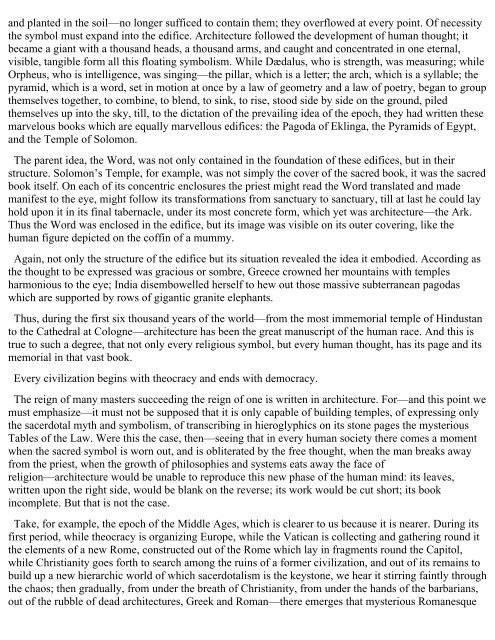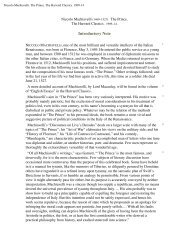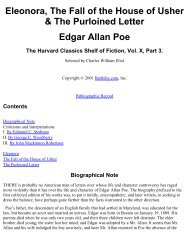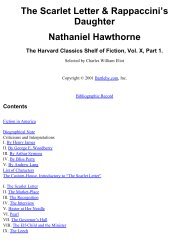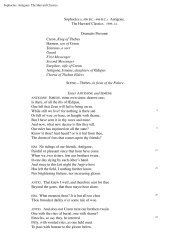Notre Dame de Paris - Bartleby.com
Notre Dame de Paris - Bartleby.com
Notre Dame de Paris - Bartleby.com
Create successful ePaper yourself
Turn your PDF publications into a flip-book with our unique Google optimized e-Paper software.
and planted in the soil—no longer sufficed to contain them; they overflowed at every point. Of necessity<br />
the symbol must expand into the edifice. Architecture followed the <strong>de</strong>velopment of human thought; it<br />
became a giant with a thousand heads, a thousand arms, and caught and concentrated in one eternal,<br />
visible, tangible form all this floating symbolism. While Dædalus, who is strength, was measuring; while<br />
Orpheus, who is intelligence, was singing—the pillar, which is a letter; the arch, which is a syllable; the<br />
pyramid, which is a word, set in motion at once by a law of geometry and a law of poetry, began to group<br />
themselves together, to <strong>com</strong>bine, to blend, to sink, to rise, stood si<strong>de</strong> by si<strong>de</strong> on the ground, piled<br />
themselves up into the sky, till, to the dictation of the prevailing i<strong>de</strong>a of the epoch, they had written these<br />
marvelous books which are equally marvellous edifices: the Pagoda of Eklinga, the Pyramids of Egypt,<br />
and the Temple of Solomon.<br />
The parent i<strong>de</strong>a, the Word, was not only contained in the foundation of these edifices, but in their<br />
structure. Solomon’s Temple, for example, was not simply the cover of the sacred book, it was the sacred<br />
book itself. On each of its concentric enclosures the priest might read the Word translated and ma<strong>de</strong><br />
manifest to the eye, might follow its transformations from sanctuary to sanctuary, till at last he could lay<br />
hold upon it in its final tabernacle, un<strong>de</strong>r its most concrete form, which yet was architecture—the Ark.<br />
Thus the Word was enclosed in the edifice, but its image was visible on its outer covering, like the<br />
human figure <strong>de</strong>picted on the coffin of a mummy.<br />
Again, not only the structure of the edifice but its situation revealed the i<strong>de</strong>a it embodied. According as<br />
the thought to be expressed was gracious or sombre, Greece crowned her mountains with temples<br />
harmonious to the eye; India disembowelled herself to hew out those massive subterranean pagodas<br />
which are supported by rows of gigantic granite elephants.<br />
Thus, during the first six thousand years of the world—from the most immemorial temple of Hindustan<br />
to the Cathedral at Cologne—architecture has been the great manuscript of the human race. And this is<br />
true to such a <strong>de</strong>gree, that not only every religious symbol, but every human thought, has its page and its<br />
memorial in that vast book.<br />
Every civilization begins with theocracy and ends with <strong>de</strong>mocracy.<br />
The reign of many masters succeeding the reign of one is written in architecture. For—and this point we<br />
must emphasize—it must not be supposed that it is only capable of building temples, of expressing only<br />
the sacerdotal myth and symbolism, of transcribing in hieroglyphics on its stone pages the mysterious<br />
Tables of the Law. Were this the case, then—seeing that in every human society there <strong>com</strong>es a moment<br />
when the sacred symbol is worn out, and is obliterated by the free thought, when the man breaks away<br />
from the priest, when the growth of philosophies and systems eats away the face of<br />
religion—architecture would be unable to reproduce this new phase of the human mind: its leaves,<br />
written upon the right si<strong>de</strong>, would be blank on the reverse; its work would be cut short; its book<br />
in<strong>com</strong>plete. But that is not the case.<br />
Take, for example, the epoch of the Middle Ages, which is clearer to us because it is nearer. During its<br />
first period, while theocracy is organizing Europe, while the Vatican is collecting and gathering round it<br />
the elements of a new Rome, constructed out of the Rome which lay in fragments round the Capitol,<br />
while Christianity goes forth to search among the ruins of a former civilization, and out of its remains to<br />
build up a new hierarchic world of which sacerdotalism is the keystone, we hear it stirring faintly through<br />
the chaos; then gradually, from un<strong>de</strong>r the breath of Christianity, from un<strong>de</strong>r the hands of the barbarians,<br />
out of the rubble of <strong>de</strong>ad architectures, Greek and Roman—there emerges that mysterious Romanesque


